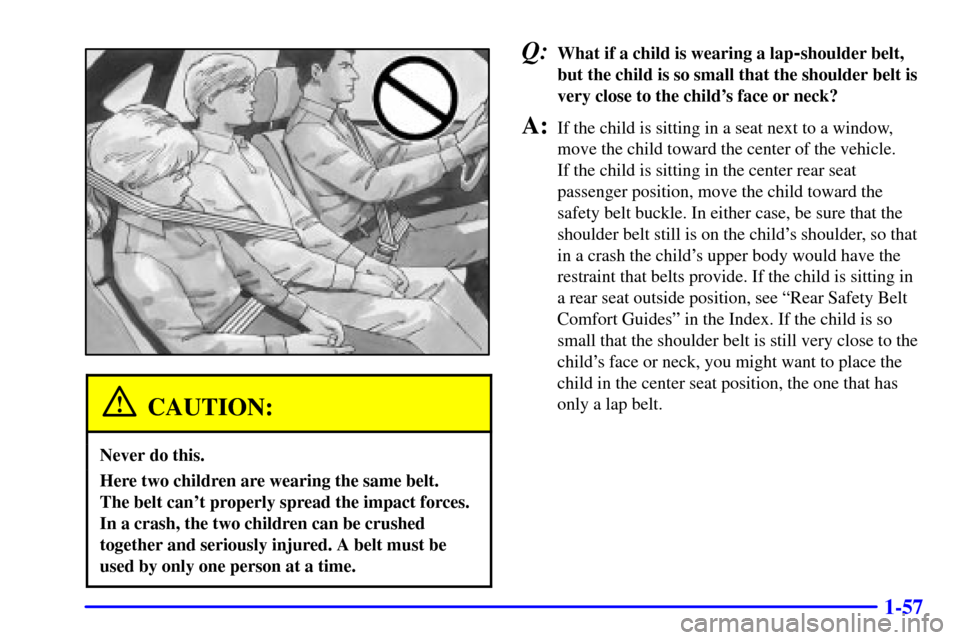Page 9 of 397
1-3 Six-Way Power Seat (If Equipped)
If your vehicle has this feature, the control is located on
the outboard side of the front seats toward the front of the
seat cushion. To adjust the seat do any of the following:
�Move the seat forward or rearward by sliding the
control to the front or the rear.
�Raise or lower the seat by sliding the control up or down.
�Raise or lower the front portion of the seat cushion
by sliding the front of the control up or down.
�Raise or lower the rear portion of the seat cushion
by sliding the rear of the control up or down.
Manual Lumbar (If Equipped)
If your vehicle has this feature, the knob is located on
the outboard side of the driver's seat. Turn the knob
toward the front of the vehicle to increase lumbar
support. Turn the knob toward the rear of the vehicle
to decrease lumbar support.
Page 34 of 397

1-28
The driver's side impact air bag is designed to inflate in
moderate to severe side crashes involving the driver's
door. The side impact air bag will inflate if the crash
severity is above the system's designed ªthreshold
level.º The threshold level can vary with specific
vehicle design. The driver's side impact air bag is not
designed to inflate in frontal or near
-frontal impacts,
rollovers or rear impacts, because inflation would not
help the occupant.
In any particular crash, no one can say whether an air
bag should have inflated simply because of the damage
to a vehicle or because of what the repair costs were. For
frontal air bags, inflation is determined by the angle of
the impact and how quickly the vehicle slows down in
frontal and near
-frontal impacts. For the side impact air
bag, inflation is determined by the location and severity
of the impact.
What makes an air bag inflate?
In an impact of sufficient severity, the air bag sensing
system detects that the vehicle is in a crash. For both
frontal and side impact air bags, the sensing system
triggers a release of gas from the inflator, which inflates
the air bag. The inflator, air bag and related hardware
are all part of the air bag modules inside the steering
wheel, instrument panel and the side of the driver's
seatback closest to the door.How does an air bag restrain?
In moderate to severe frontal or near frontal collisions,
even belted occupants can contact the steering wheel
or the instrument panel. In moderate to severe side
collisions, even belted occupants can contact the inside
of the vehicle. The air bag supplements the protection
provided by safety belts. Air bags distribute the force of
the impact more evenly over the occupant's upper body,
stopping the occupant more gradually. But the frontal air
bags would not help you in many types of collisions,
including rollovers, rear impacts, and many side
impacts, primarily because an occupant's motion is not
toward the air bag. The side impact air bag would not
help you in many types of collisions, including frontal
or near frontal collisions, rollovers, and rear impacts,
primarily because the occupant's motion is not toward
that air bag. Air bags should never be regarded as
anything more than a supplement to safety belts, and
then only in moderate to severe frontal or near
-frontal
collisions for the driver's and right front passenger's
frontal air bags, and only in moderate to severe side
collisions for the driver's side impact air bag.
Page 48 of 397
1-42
Restraint Systems for Children
An infant car bed (A), a special bed made for use in a
motor vehicle, is an infant restraint system designed to
restrain or position a child on a continuous flat surface.
Make sure that the infant's head rests toward the center
of the vehicle.
A rear-facing infant seat (B) provides restraint with
the seating surface against the back of the infant. The
harness system holds the infant in place and, in a crash,
acts to keep the infant positioned in the restraint.
Page 63 of 397

1-57
CAUTION:
Never do this.
Here two children are wearing the same belt.
The belt can't properly spread the impact forces.
In a crash, the two children can be crushed
together and seriously injured. A belt must be
used by only one person at a time.
Q:What if a child is wearing a lap-shoulder belt,
but the child is so small that the shoulder belt is
very close to the child's face or neck?
A:If the child is sitting in a seat next to a window,
move the child toward the center of the vehicle.
If the child is sitting in the center rear seat
passenger position, move the child toward the
safety belt buckle. In either case, be sure that the
shoulder belt still is on the child's shoulder, so that
in a crash the child's upper body would have the
restraint that belts provide. If the child is sitting in
a rear seat outside position, see ªRear Safety Belt
Comfort Guidesº in the Index. If the child is so
small that the shoulder belt is still very close to the
child's face or neck, you might want to place the
child in the center seat position, the one that has
only a lap belt.
Page 72 of 397

2-6
Door Locks
CAUTION:
Unlocked doors can be dangerous.
�Passengers -- especially children -- can
easily open the doors and fall out of a
moving vehicle. When a door is locked,
the handle won't open it. You increase the
chance of being thrown out of the vehicle in
a crash if the doors aren't locked. So, wear
safety belts properly and lock the doors
whenever you drive.
�Young children who get into unlocked
vehicles may be unable to get out. A child
can be overcome by extreme heat and can
suffer permanent injuries or even death
from heat stroke. Always lock your vehicle
whenever you leave it.
�Outsiders can easily enter through an
unlocked door when you slow down or stop
your vehicle. Locking your doors can help
prevent this from happening.
There are several ways to lock and unlock your vehicle.
From the outside, use your key or remote keyless entry
transmitter (if equipped). From the inside, use the
manual or power door locks.
To unlock either front door from the outside with the
key, insert the key and turn it toward the front of the
vehicle. To lock either front door from the outside with
your key, insert the key and turn it toward the rear of
the vehicle.
To lock the door from the inside, push the manual
lock lever forward. To unlock the door, pull the
lever rearward.
Page 80 of 397
2-14 Trunk Lock
To unlock the trunk from the outside, insert the key in
the lock and turn it. You can also press the car symbol
on your remote keyless entry transmitter (if equipped).
Remote Trunk Release
You can also unlock the trunk from inside the vehicle.
Press the button located
below the exterior lamps
control on the underside of
the dashboard. The shift
lever must be in PARK (P)
for the remote trunk release
button to work.
Trunk Assist Handle
There is an assist handle located on the inside of the
trunk lid toward the driver's side of the vehicle.
Page 83 of 397

2-17
Disabling the Trunk Release Sensor
A. Sensor Lens
B. Disable SwitchBecause the sensor detects motion, there are times when
you may want to turn off the trunk sensor so that the
motion of your vehicle or items in the trunk won't cause
the trunk to open, such as the following:
�when your vehicle is transported on a car ferry,
�when your vehicle is towed, or
�when you will be loading items through the opening
in the split folding rear seat (if equipped).
Next to the sensor lens, there is a disable switch you can
use to turn off the trunk release sensor. To turn off the
sensor, turn the ignition to ON and press the switch next
to the lens for two seconds. The horn will chirp once
when the sensor is turned off. When the sensor is off,
the light in the switch will flash. The TRUNK OPEN
message in the message center will flash for one minute
each time the ignition is turned on as a reminder that
the sensor is turned off. See ªTrunk Open Messageº in
the Index.
To turn the sensor on again, press the switch again
or open the trunk. When the trunk is opened, the
sensor is automatically turned back on. If the sensor is
turned back on with the disable switch, the horn will
chirp twice.
Page 96 of 397

2-30
Passlock�
Your vehicle is equipped with the Passlock
theft
-deterrent system.
Passlock is a passive theft
-deterrent system. Passlock
enables fuel if the ignition lock cylinder is turned with a
valid key. If a correct key is not used or the ignition lock
cylinder is tampered with, fuel is disabled and the
engine will not start.
During normal operation, the SECURITY message will
be displayed after the key is turned to the ON ignition
position. See ªMessage Center, Securityº in the Index.
If the engine stalls and the SECURITY message flashes,
wait until the light stops flashing before trying to restart
the engine.
If the engine is running and the SECURITY message
comes on, you will be able to restart the engine if you turn
the engine off. However, your Passlock system is not
working properly and must be serviced by your dealer.
Your vehicle is not protected by Passlock at this time. You
may also want to check the fuse (see ªFuses and Circuit
Breakersº in the Index). See your dealer for service.
In an emergency, contact Chevrolet Roadside
Assistance. See ªRoadside Assistanceº in the Index for
more information.
New Vehicle ªBreak-Inº
NOTICE:
Your vehicle doesn't need an elaborate
ªbreak
-in.º But it will perform better in
the long run if you follow these guidelines:
�Don't drive at any one speed -- fast or
slow
-- for the first 500 miles (805 km).
Don't make full
-throttle starts.
�Avoid making hard stops for the first
200 miles (322 km) or so. During this time
your new brake linings aren't yet broken
in. Hard stops with new linings can mean
premature wear and earlier replacement.
Follow this breaking
-in guideline every
time you get new brake linings.
�Don't tow a trailer during break
-in.
See ªTowing a Trailerº in the Index for
more information.